In this article, I scratch the surface of Generative AI, no matter your technical savviness, there’s something for you.

I started writing this article about 6 months ago, and then finally came back to update it and wrap it up. If you know a lot about this topic, it’s probably not for you, but for everyone else, I think you’ll learn something. My next article is going to cover more ways you can create value from this technology, watch outs and metrics that matter.
We’ve seen the likes of ‘GenAI’, ‘Generative AI’, ‘ChatGPT’ and ‘LLM’ rocket the trends charts, mentions all over the internet, and probably your internal tools like Slack and Teams, and of course interactions with senior leaders. ‘Generative AI’ is the broader technology that’s all about creativity and content generation, and ‘LLM’ (Large Language Model) is a type of generative AI that specifically focuses on text-based content.
This technology has boomed this year, you can see the peak from the beginning of 2023 in the graph below:
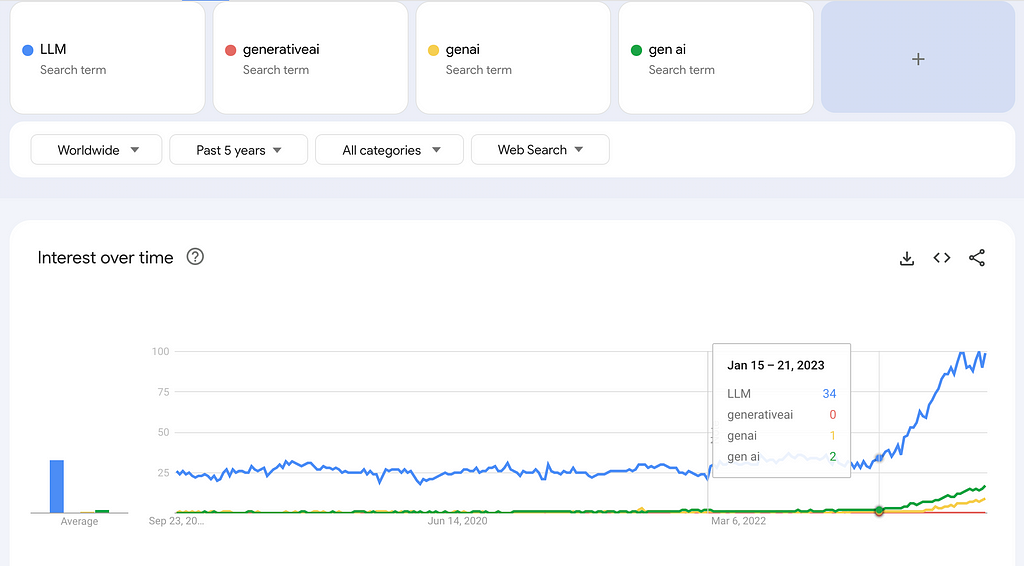
And then, if we throw in ChatGPT that makes all of the above look insignificant.
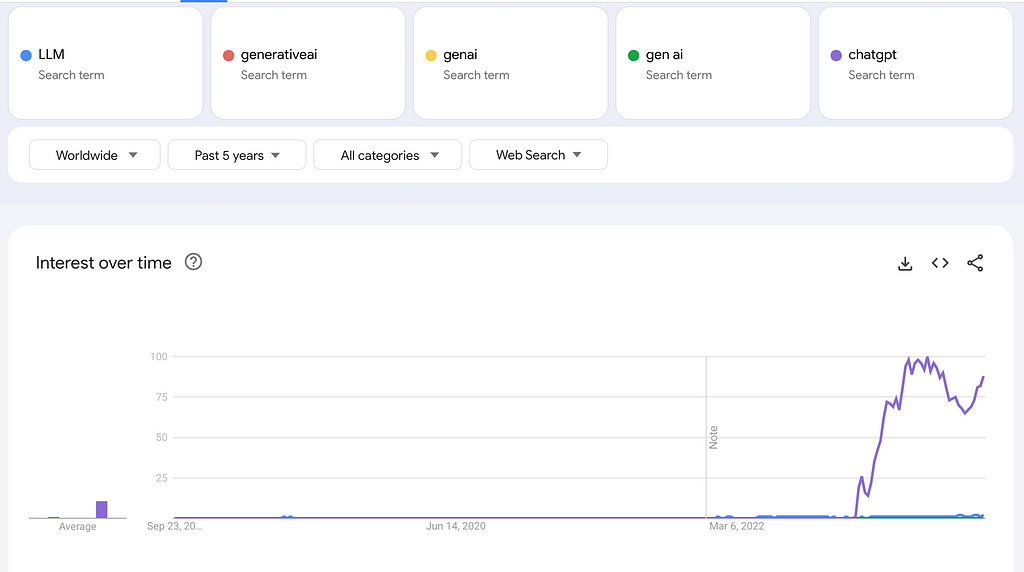
If you’ve heard of ChatGPT but never used it, or never heard of it, it’s an application built over a ‘Large Language Model’ (LLM), which has been trained on a massive amount of text-based data from the open internet. This means, this model has captured the contents of web pages, research papers, books etc., which means that the web app they’ve built, is your gateway to knowledge, hints, tips and more productivity hacks.
I personally have ChatGPT pinned on my browser and I use it instead of Google search for a lot of things, apart from my retail therapy of course. Below shows the example of me asking both ChatGPT and Google the same thing to demonstrate the differences:
Prompt: tell me the best place to visit in napoli and why?
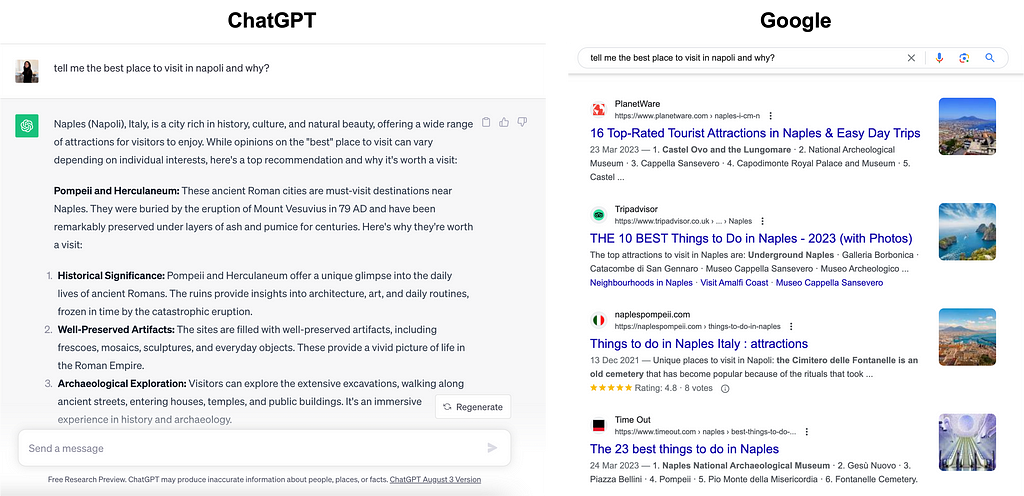
`Whilst ChatGPT isn’t visual, it gives me the answer quickly and in an easy to read format, whereas Google shows visuals but I need to tap into each and every link to explore, which I can choose to date at a later point during planning a trip. By the way, Google does have it’s own version of ChatGPT, and that’s called Bard, and there’s a bunch of others out there now too.
I find it pretty enjoyable explaining new tech to someone that’s not working in this space, and many of my past articles aim to educate anyone and everyone, and this one’s the same. This year’s launch of things like ChatGPT, led to moments like this with friends and family…

It reminded me of the time I told my grandparents you could get music playing from the speakers on the other side of the room from their tablet, or when they used my mobile phone for the first time and stood still, not realising you could move. Technology really is a beautiful thing when it brings a whole new world to people.
The hype is real for some
Every year I like to see the Gartner Hype Cycle, and compare to previous years. If you’ve not seen this, here it is for reference below:
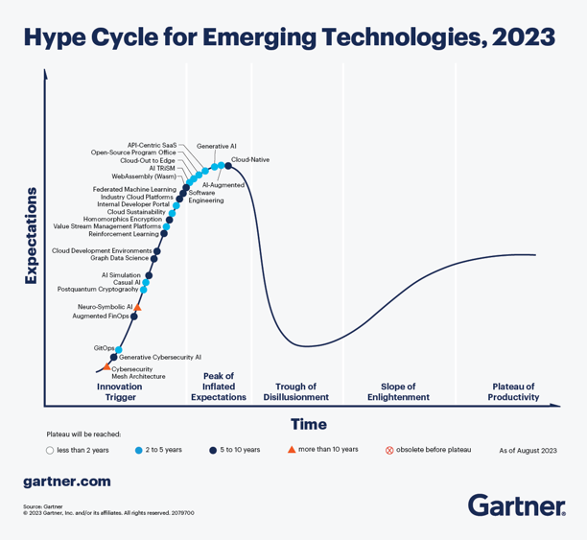
You’ll see ‘Generative AI’ sitting at the ‘Peak of Inflated Expectations’ from the 2023 hype cycle which landed last month, in August. There’s always random things on these, and each year new things come, and things from the past show up again in the same or different naming convention.
In all of this hype, many have jumped on the band wagon, and hey, I’m here writing about it… but on to others:
Consulting firms have written papers for their executive clients in an attempt to drive revenue from this hype. A lot of talk, and little building of things, as well as races to partner with AI based start-ups.


Intercom got onboard super early with this technology and launched some lovely, useful applications. My favourite was the productivity hack for customer service advisors, that are messaging / chatting to customers. The new feature basically summarises the conversations, so the agent gets a good grounding of what’s happened so far in the chat, quickly, so they can focus on resolving the customers’ problem.
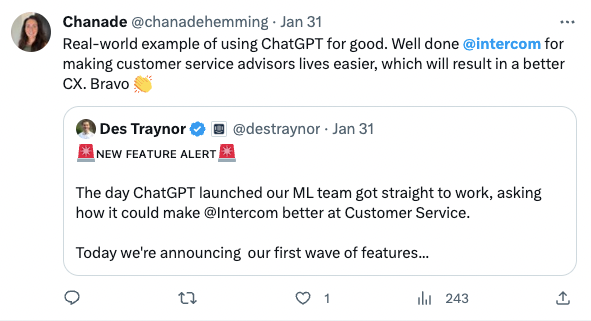
Expedia made the dreaming phase of booking a trip easier, by working with OpenAI too, enabling users to ask questions you’d probably ask a travel agent, but without leaving your home, office, bed, sofa…
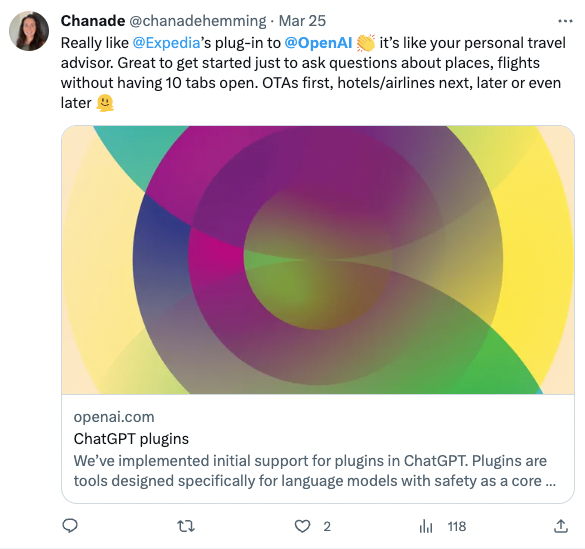
Many companies have seen their employees diving into using apps like Open AI’s ChatGPT and Google’s Bard, writing sensitive company information. For example, Samsung blocked the use of these applications as an employee wrote sensitive software code into ChatGPT which would then be available to the public.

This is because, when you ‘feed’ these applications, they take that data into the Large Language Model and it is used to then train it, so when people asked particular questions it could store that input and use it as an answer in future.
And there’s a bunch of companies and consultants too, that have made big claims to executives, probably gone to build things, and not thought things through or really understood the technology to create value early on, that’s proven with for example, frontline colleagues.
Say it all you want, it’s not Candyman
I got to a point this year where I didn’t enjoy opening Twitter. It was flooded with everyone being an expert in LLM’s.
On the topic of Candyman, it’s referring to the movie. You may remember that when someone stares in the mirror and says “candyman, candyman, candyman”, Candyman appears (anyone else petrified of doing this incase he appeared 😅 — oh the imagination!)… anyway, my point is, that no matter how many times your execs or anyone else around the company repeats ‘GenAI’, ‘LLM’ etc, it won’t magically happen.
This stuff takes smart people to consider the application of technology where it’ll matter most, how to do it safely, and then to build something small but big enough to prove or disprove a hypothesis.
I’m fortunate to work with some of the best in the game like Gilles Comeau, and Alberto Rey Villaverde that made some of our early thinking a reality. The truth is, we knew this technology could be applied to our company and drive value, but really, we knew that consultants would be very quick to bring shiny slides to our execs on ‘how to transform productivity in your company and get a computer doing it all’, so we went first and built some stuff, quick and dirty, but demo-able, which resulted in people ‘getting it’, and then betting on opportunities and also throwing some new bets in themselves, which is a fantastic place to be.
Real-world opportunities in everyday life with some of this tech
This technology is already, and will continue to boost many things in our day to day lives. It can literally be applied to your everyday lives in and outside of work, as well as how companies / organisations do things. Productivity and ease is the key for me here. Whilst throughout this article I mentioned many examples, here’s some more:
Next time you need an image for a [blog, presentation, website…]
You can use something called Midjourney — this is a text to image app, you tell it what you’d like to create and it’ll do it, and in many variations. You can even go as far as describing the camera you’d like to take the shot for full effect. This poses the questions of the life of stock image libraries like Shutterstock and iStock. I mean, those companies saw competition, when people’s camera phones were shooting pretty awesome shots. This isn’t free so you’ll need to pay for it, but it’s pretty damn good. There are free versions out there but they’re not as good.
When you’re writing get some assistance with tone, style, length
Grammarly has been around for a long time now, and you may have used it. But this year, they enhanced their product with Generative AI. So before, when you were typing, it made suggestions to your writing to make it better. Microsoft Word has been pretty good at this, and in recent times scores your writing with a percentage. So without even realising you’ve been assisted by technology that’s learning what good looks like, and giving you hints. But beyond this, now with new technologies, you can now shorten what you’ve written, ask it to ‘make it more fun’, ‘make it more professional’…
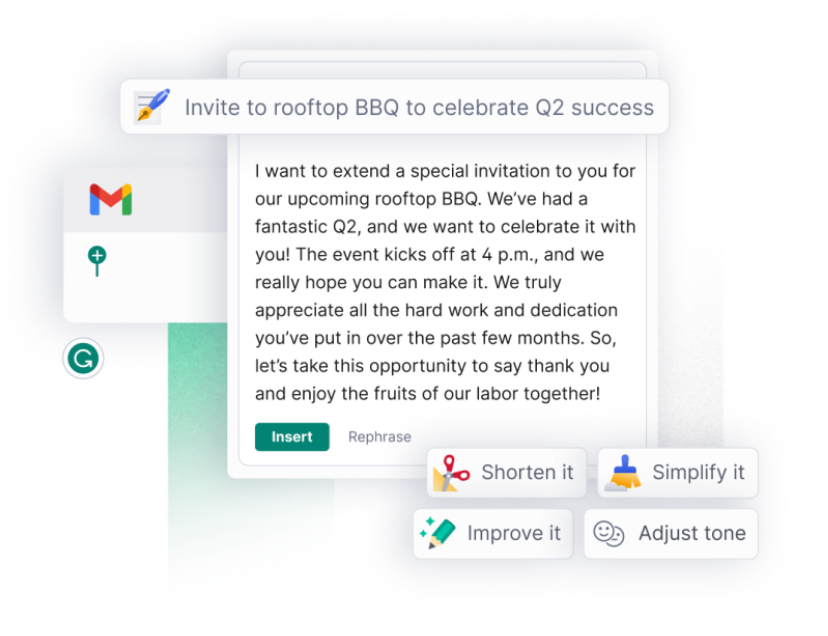
Want to know what monthly bills you’ve got?
Google’s version of ChatGPT, Bard — has had ups and downs, but this week (September 2023) I spotted some mega useful features, where it could search your email inbox and get all of your subscriptions out for you — props to Huseyin Savas for sharing this.
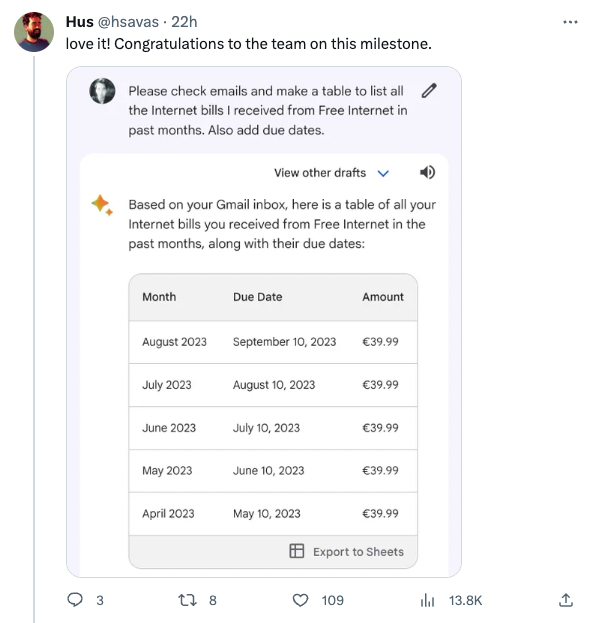
There’s tons of other things, think about when you know there’s something in your inbox and you scroll and scroll, and when you use search it’s pretty poor. Well, Bard makes all of that better. I certainly won’t be asking, “how many times have I ordered from ASOS this year?”.
Got a thing coming up and after some ideas?
You can be super descriptive and get a response back. Google search would be like “give me ideas for a 10 year olds party” — and you’d get a ton of links back.
Planning an event
Prompt: I’m hosting a 10 year olds party with 6 friends, they’re sleeping over too. It starts at 3pm on Saturday and they’re getting picked up at 11am Sunday. Can you give me some ideas to keep them entertained, but tired, so they go to sleep at 10pm
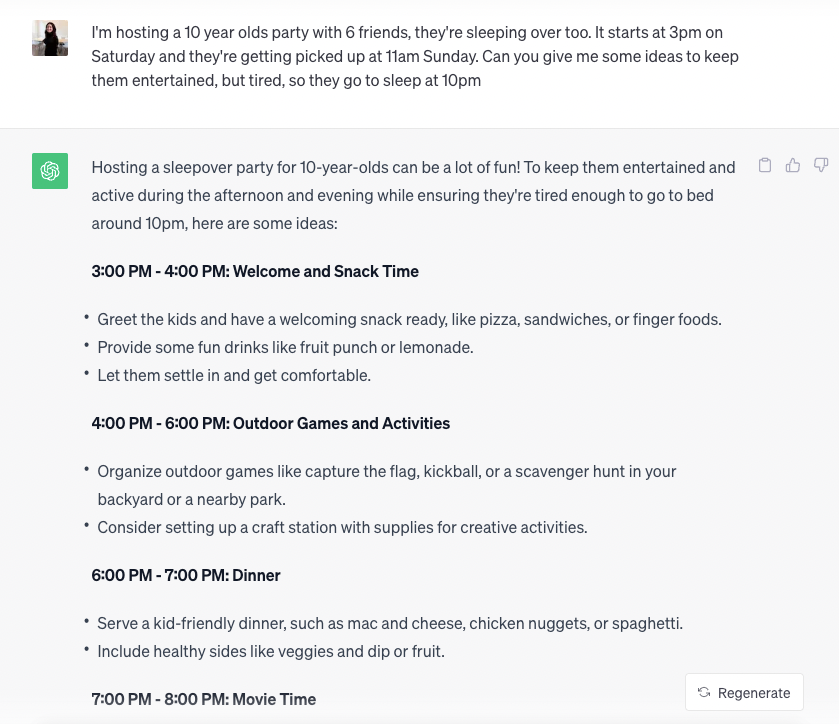
Prompt: I’m planning a workshop for 10 people in person from 10AM to 3PM. I’d like to put a break at 12PM. The session needs to be energising and make room for team building as well as strategy. Give me some ideas for the agenda.
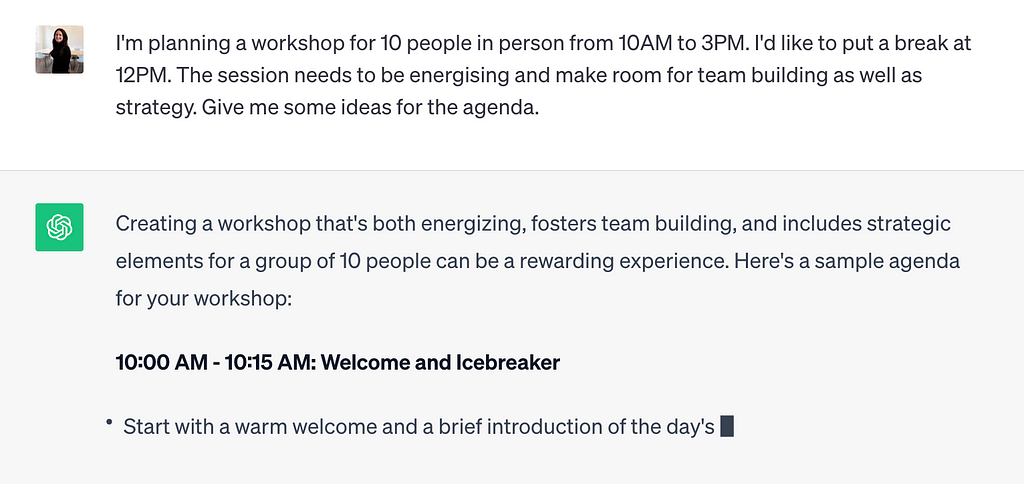
Things to do on a trip
Travelling somewhere? Ask ChatGPT for some advice on what to do.
Prompt: I’m going to Nashville for work Monday to Friday, I have free time on Wednesday night, and Thursday morning. What can I do to experience this place like a local?

Create templates quickly
In the work I do as a Product Manager, I’m looking for templates from time to time and for speed, why not get someone to do it for you.
Prompt: make me a product requirements document template
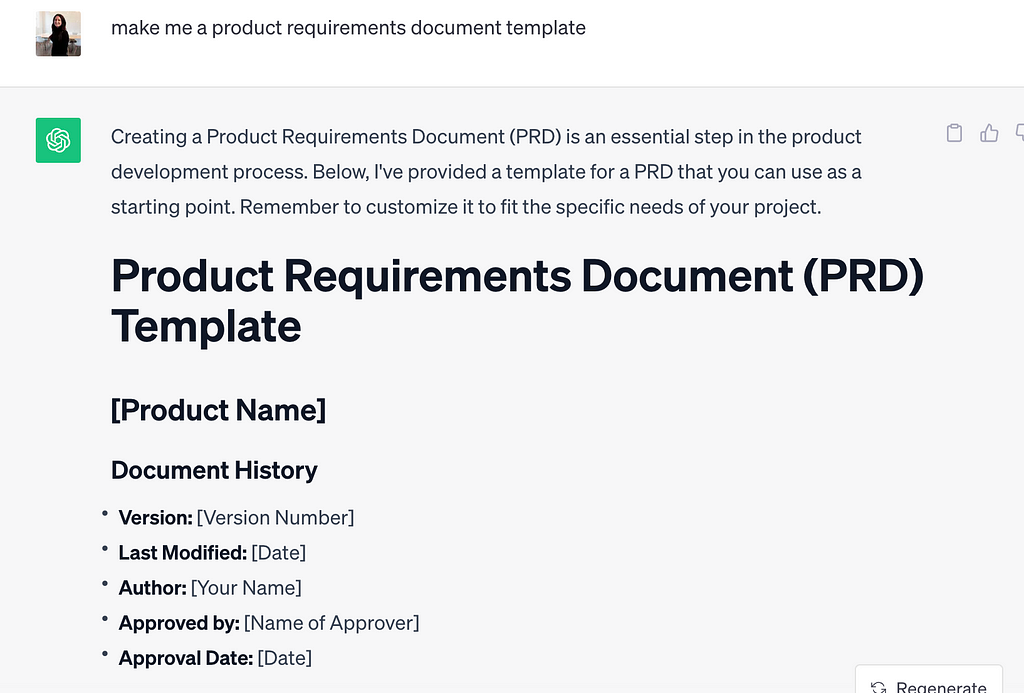
Learning something new at 100x speed
Given that pretty much the whole of the internet is available, you can accelerate your learning of a topic. It could be “what’s the best time to grow vegetables in my garden and how should I go about it as a beginner”.
…at this point, I’m not copying anymore ChatGPT examples, I’m sure you get the picture and how useful this is and can be to you.
Beyond ChatGPT and Bard the winner of applying GenAI this week is…
Game, Set, Match to Spotify — this is THE winning one for me. Spotify is piloting podcasts in another language using this technology.
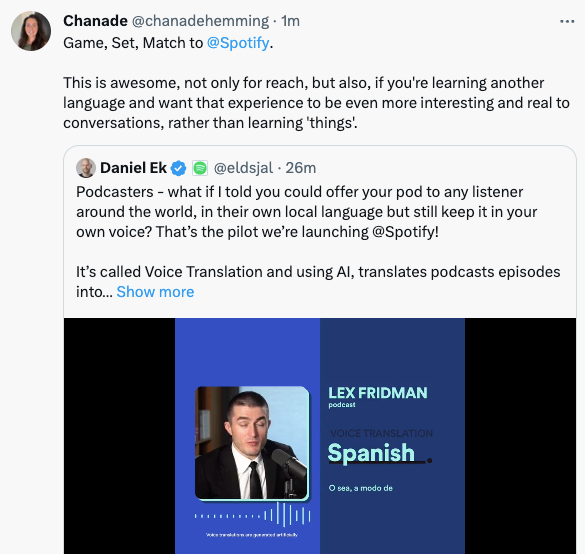
So your favourite podcast is in English, you want to listen to it in Spanish — no problem.
The possibilities are endless
You’ve seen from this article the many wonders of this technology, and I only scratched the surface. From figuring out what to do on your next trip, to planning a kids party, to getting a view of your bills that hit your inbox monthly, there’s so much that can be done. And in the workplace, it’s pretty mind-blowing when you collaborate with domain experts to surface problems/opportunities, and team members have lightbulb moments which can lead to better customer / employee experience, cost saving, revenue generation and so on. It does require a ton of smart people, and quality data (more of that in the next article).
Have a play with the tools I mentioned, embrace the possibilities, and let your imagination run wild like it did when you were a kid! We’ve seen many technological advancements, and this is another one, be part of it. If your company has blocked ChatGPT then you can try Bard.
You wouldn’t share confidential information with a stranger, so don’t write it in ChatGPT or Bard. Don’t put sensitive company or personal information into the likes of ChatGPT or Bard. You’ll be feeding into a brain, that’s constantly learning. But as explained in this article, do use these tools to boost your productivity at home and at work.
Technology for the sake of technology is no good, but when technology is applied to getting things done in a better way, that gives us time back to focus on things that matter most, then to me, it‘s very good.
Generative AI, a 101 for everyone was originally published in UX Collective on Medium, where people are continuing the conversation by highlighting and responding to this story.

Leave a Reply